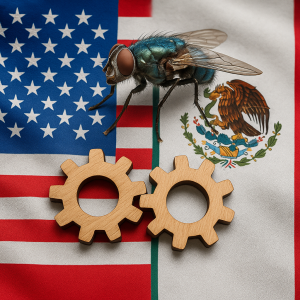Widgetized Section
Go to Admin » Appearance » Widgets » and move Gabfire Widget: Social into that MastheadOverlay zone
Coordinating Against Crisis: Lessons From the Screwworm Outbreak
The views expressed are those of the author and do not necessarily reflect the views of ASPA as an organization.
By Mauricio Covarrubias
June 13, 2025

Coordination is often hailed as the answer to today’s complex policy problems. But coordination without capacity is like a plan without action—promising on paper, paralyzing in practice. Yet, as Harold Seidman warned in Politics, Position, and Power, expecting a “perfect formula” for coordination to resolve contradictions, align divergent interests or make tough decisions universally acceptable is an illusion. Nowhere is this more evident than in U.S.–Mexico relations, where federal fragmentation and institutional weakness limit response capabilities. The recent screwworm (Cochliomyia hominivorax) outbreak illustrates this clearly: coordination alone fails when responsibilities are dodged and institutional capacity is lacking.
Coordination Put to the Test
The screwworm, a parasitic fly eradicated from North America in the 1990s using the sterile insect technique, reemerged in Central America in 2023 and reached Mexico’s southern border by 2024. In April 2025, a human case was confirmed in Chiapas. Mexico pointed fingers at the U.S., arguing that its regional facility—the only one producing sterile flies—failed to contain the pest’s spread. Meanwhile, U.S. border states criticized Mexico’s delayed response.
Mechanisms such as the historic U.S.–Mexico Commission for the Eradication of Screwworm laid the foundation for current cooperation between the two countries. However, the scale and speed of the present outbreak have overwhelmed the available resources and coordination protocols.
Mexican livestock exports were temporarily suspended, affecting thousands of producers, while U.S. border states reported significant losses. With direct economic losses surpassing $320 million in 2024, the crisis laid bare the limits of coordination unsupported by strong institutions.
Structural Limits
Effective coordination hinges on shared responsibility, yet both nations resorted to blame. In Mexico, SENASICA, the agency tasked with pest control, has faced budget cuts of nearly 30 percent since 2020, weakening its technical and operational capacity. In the U.S., inconsistent state-level responses—some states struggled with delayed federal funding for containment—further hampered efforts. Millions of sterile flies are released weekly in southeastern Mexico, but public data on geographic coverage or operations in high-risk areas remains scarce, hindering accountability and evaluation.
As Elinor Ostrom noted in Governing the Commons, cooperation falters without strong local capacities. Regional disparities were evident: while some areas organized effective training and containment, others, constrained by limited resources, lagged behind. Coordination, absent strong institutions and mutual commitment, loses its edge.
Fragmented Federalism
Federal systems complicate joint responses. The autonomy of state and local governments can lead to actions that diverge from national or binational goals, resulting in uneven resource allocation and inconsistent implementation. Donald Kettl, in The Transformation of Governance, argues that without mechanisms to align incentives across government levels, coordination risks becoming symbolic. In this case, the lack of enforceable frameworks and clear authority weakened even well-designed agreements.
Institutional Capacity: The Missing Piece
Peter M. Haas, in Introduction: Epistemic Communities and International Policy Coordination, emphasizes the role of expert networks—groups of specialists who build technical consensus—in effective policy coordination. These networks need political and financial backing to thrive. Reports suggest a decline in U.S.-Mexico joint research projects since 2020, though exact figures are unavailable, reflecting transparency gaps. Both countries have pledged to strengthen cooperation to control the screwworm, but success depends on local capacity. The sterile fly technique, central to containment, requires robust infrastructure and trained personnel. Regions with fewer resources face greater challenges, making coordination fragile without sustained investment. As David L. Weimer and Aidan R. Vining note in Policy Analysis: Concepts and Practice, disparities in program implementation only worsen the crisis.
A Path Forward
The screwworm crisis offers critical lessons for public management in regionally interdependent contexts. Coordination cannot substitute for institutional strength. To address this:
- Strengthen Institutions. Ensure agencies like SENASICA and U.S. counterparts have adequate human, technical, and financial resources. Without a robust operational foundation, international cooperation is unsustainable.
- Define Responsibilities. Establish bilateral agreements with verifiable commitments and clear rules to prevent finger-pointing.
- Reinforce Governance Structures. Equip binational bodies with budgets, legitimacy and intervention capacity to act decisively.
- Prioritize Expert Knowledge. Invest in applied research, evidence generation and collaboration among technical teams to tackle complex challenges with collective intelligence.
Conclusion
The screwworm crisis reveals that coordination alone cannot resolve emergencies. Cross-accusations between Mexico and the U.S., coupled with weak joint mechanisms, reflect deeper issues: fragmented systems and eroded capacities. With over $320 million in losses in 2024, the lesson is stark—coordination works only when built on solid structures, clear rules, and real capabilities.
The next outbreak is not a question of if, but when. Coordination must evolve from a diplomatic buzzword to an operational reality—before the costs become unbearable.
Author: Mauricio Covarrubias is Professor at the National Institute of Public Administration in Mexico. He is co-founder of the International Academy of Political-Administrative Sciences (IAPAS). He is the founder and Editor of the International Journal of Studies on Educational Systems (RIESED). Member of the National System of Researchers of CONAHCYT. He received his Ph.D. from the National Autonomous University of Mexico. He can be reached at [email protected] and followed on Twitter @OMCovarrubias


Follow Us!